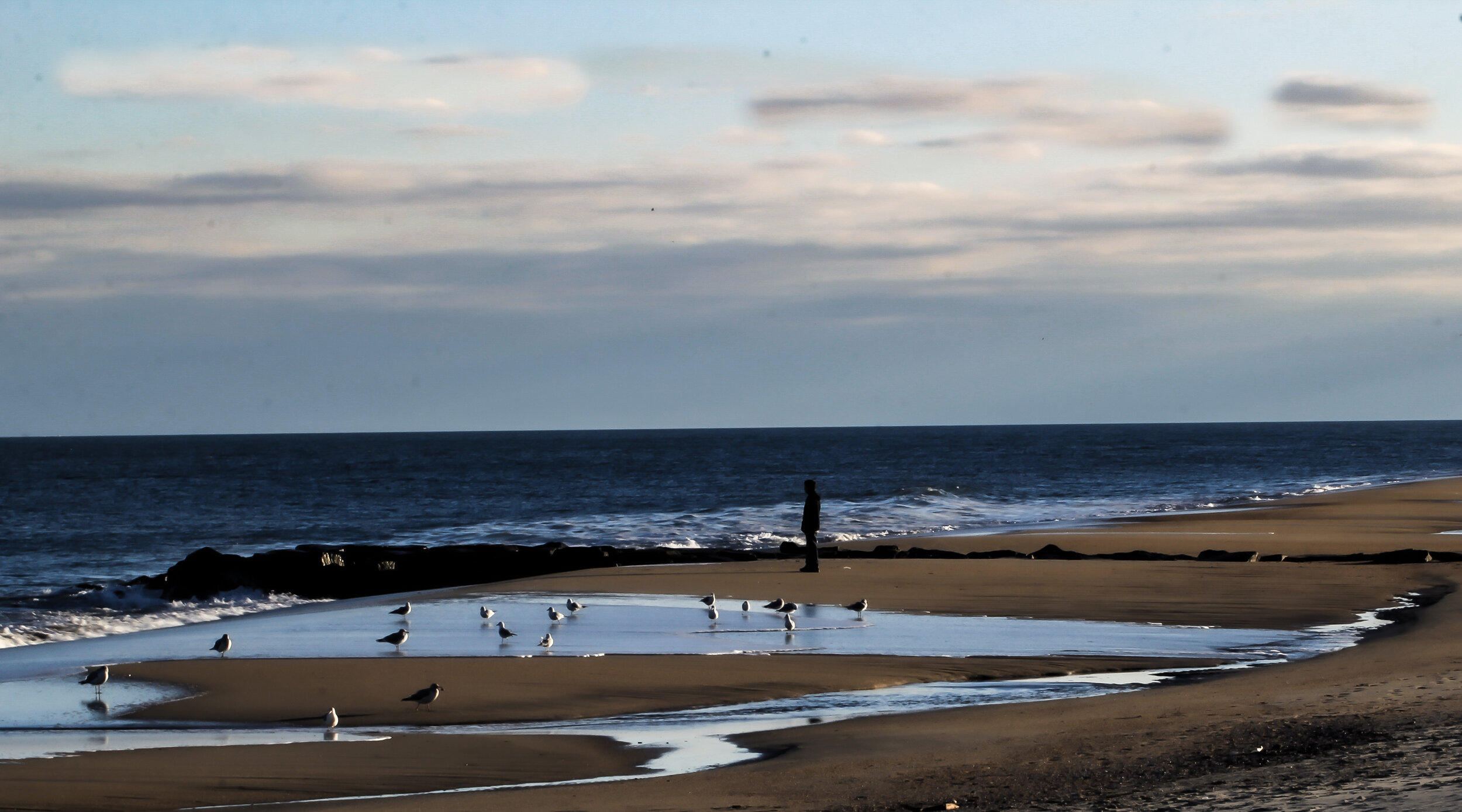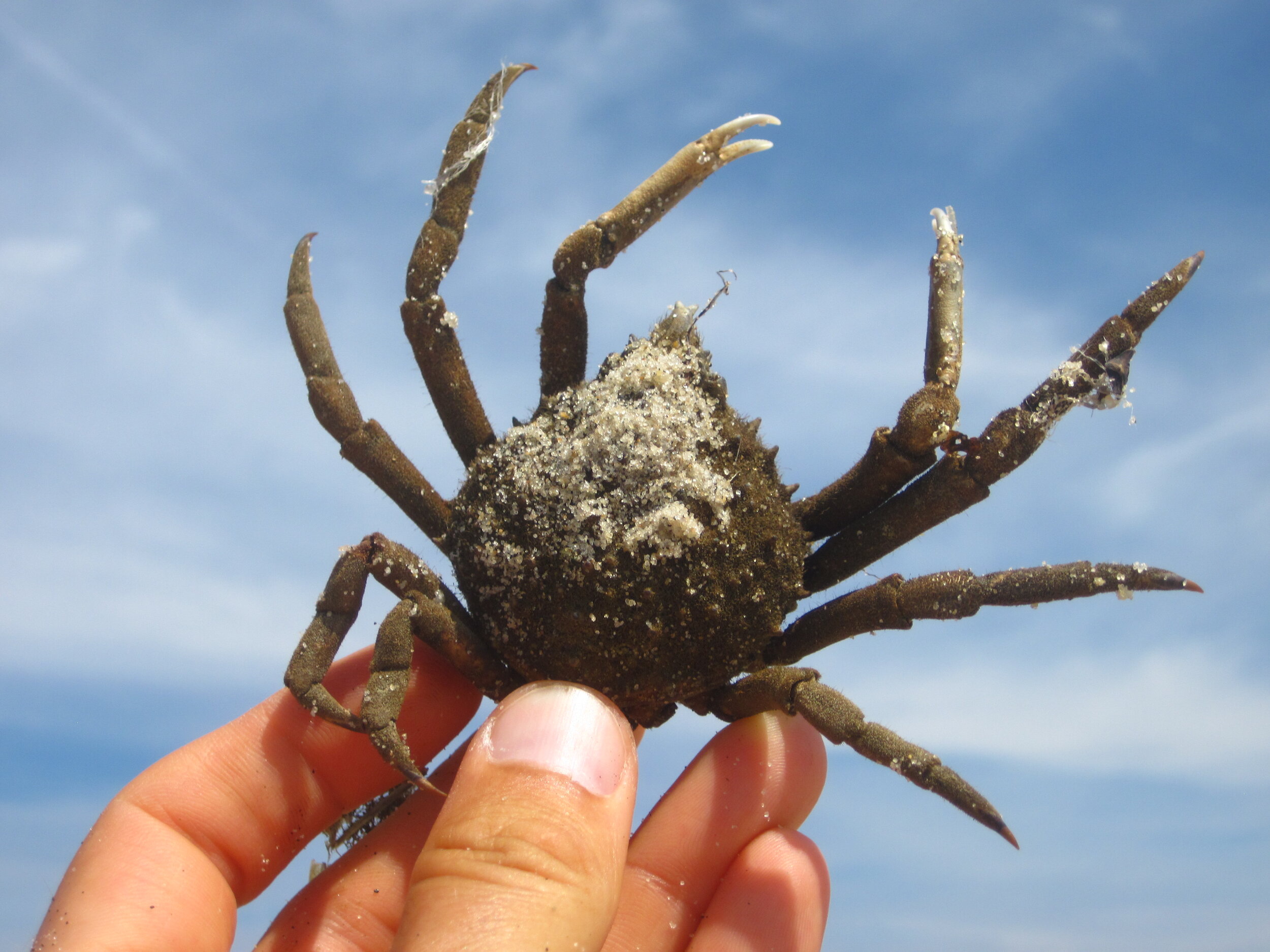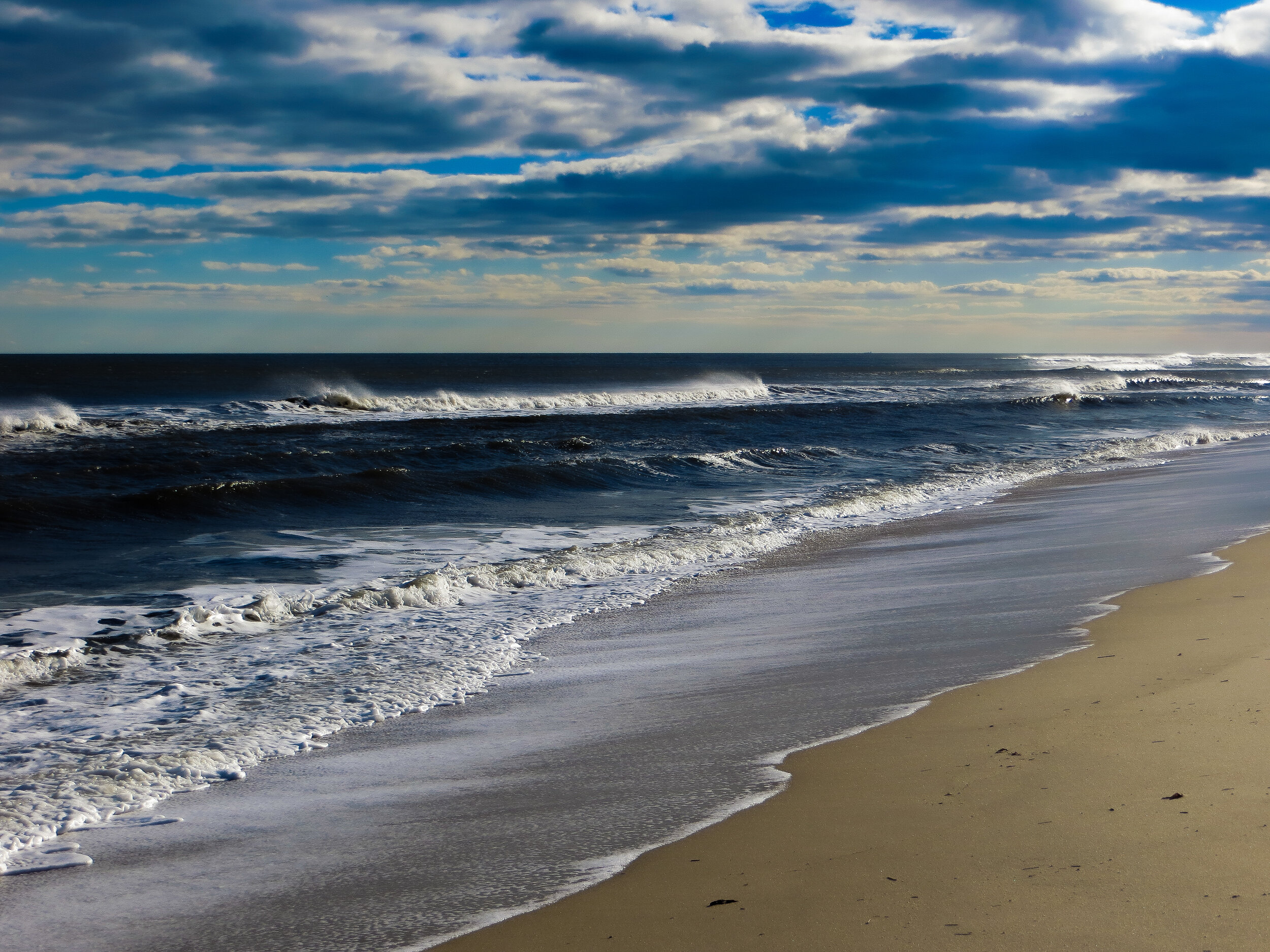A Winter Beach Along the Jersey Shore
Written by Jenna Reynolds, President of Save Coastal Wildlife
Winter weather along the Jersey Shore can be a cruel and cold. Old Man Winter, the embodiment of winter and frosty weather, is constantly unpredictable. The weather at times can be balmy and mild, but other days it can be as lousy as a little ice age.
It was roughly two weeks after the last winter solstice and air temperatures were in the 50s Fahrenheit. I thought it would be a great day to take a walk on a beach. Yet Old Man Winter had other plans. Predominately gray skies and gale force winds from the north dominated the landscape creating freezing wind chills and rough seas. A cold front was underway bringing forth a cold rain. Winds were sloshing water higher and higher onto the beach, whipping up surf to worsen beach erosion and expand the sound of waves rumbling and crashing near me.
A cold and barren beach of public activity during the winter.
“Winter beach, the very words seem to be powerfully evocative,” declared journalist and author, Charlton Ogburn, Jr in his classic book: The Winter Beach: A Naturalist and Man of Rare Wisdom Shares With You His Journeys Along the Atlantic Coast, first published in 1966. He interprets the winter beach landscape as a place of energy and a “sense of timelessness induced by the procession of waves plunging upon the strand with elemental power from an inexhaustible store; the astringency of the clean, spume-edged winds; the emptiness and the vastness of the solitude it connoted.” There is much to behold and beauty to be found on a winter beach.
Even though the temperatures and winds can be a brutal and biting, a walk on a winter beach has the potential to be among the most satisfying of all natural events during the year, especially if you have mastered the art of layering clothes. Trust me, layering clothes before a winter beach walk is truly an art form, from long underwear to a long coat.
I adore the time I spend walking along a beach during the winter. No crowds, and with fewer people and distractions, it’s easier to focus and enjoy the natural world: a sunrise or sunset, the movement of clouds and water, and flocks of sandpipers foraging along the water’s edge. I get to experience everything that comes with being along the coast, but even more intimately than during the summer.
While a beach during both the summer and winter is technically a parallel ecosystem, the same beach can look and feel quite different depending on the season. During the winter, winds and waves combine to reshape the topography. The beach is narrower than the summer beach due to high-energy waves during the winter, especially after a powerful nor’easter. Hammering waves and relentless strong northerly winds help to redistributes grains of sand, from the dunes to the water. Motion is a constant for a single grain of sand, just as change is constant for a beach. Winds have a direct influence on tiny sand particles, they are often windborne and collect in clam shells, behind driftwood, beach fences, or any place that allows relief from forceful streams of air.
Large patches of magnetite sand is usually found near the high tide line on a beach along the Jersey Shore.
Winter winds and powerful waves also combine to expose a wonderful surprise for the cold-weather walker - patches of dark or black sand on a beach. The color is not from oil pollution, as some people believe, but from the presence of abiotic heavy minerals including magnetite and pyrite. These dark solid particulars, frequently found near the high tide line, tend to be truly heavy compared to light minerals on a beach such as quartz, feldspars and fragments of shells (carbonate minerals). This assemblage of dark and light minerals on a beach is wholly explained by William J. Neal and others in their book entitled, Atlantic Coast Beaches: A Guide to Ripples, Dunes, and Other Natural Features of the Seashore, published in 2007. The authors explain:
“Because of this difference in density of individual mineral grains, wind and water – even of low moderate intensity – move light grains, such as quartz. With the less dense quartz grains gone, the more dense minerals are left as dark patches on beaches. Such sorting by density is called placering, and after a storm the black placer deposits at the back of a beach may be several inches to more than a foot thick.”
You can feel for yourself just how heavy minerals of magnetite are compared to the lighter quartz minerals. Scoop up a decent amount of black sand in one hand and an equal amount of light sand in the other hand. The dark sand should feel relatively heavier compared to the light-colored minerals.
Magnetite is one of two major sources of iron, the other is hematite. This high iron content gives magnetite its denseness and black color. The most striking property of magnetite - it’s highly magnetic and strongly attracted to a hand magnet, provided the sample is clean and dry. If you want to provide some cheap and easy amusement to friends and family, remember to take two hand magnets with you the next time you visit a beach. Roll the magnets in the sand to collect your own magnetite, and then see what kind of sculptures you can make on the sand using just magnets and magnetite.
Black patches of magnetite sand.
But where does all this sand come from? Some sand along the Jersey Shore comes from the weathering and erosion of shells over time. Most, however, comes far inland. From Piedmont and Appalachian Mountains of northern New Jersey, New York and Pennsylvania. Tens of millions of years ago, minerals eroded from mountain rocks. The minerals washed down through the watershed via rivers and streams to the coast. From there, tides and coastal currents moved the minerals to form a beach along the edge of a wetland or maritime forest. This erosion of mountain rocks still takes place today, but at a very slow rate. Too slow in fact to the ease the rate of beach erosion taking place from the melting of land-based ice due to global warming.
The most common light grains of sand along the Jersey Shore or on many East Coast beaches are quartz, which is just crystallized silica. Emily Schnebele, a USGS mineral commodity specialist, in an article about silcon for the American Geosciences Institute tells us:
“Almost 30 percent of Earth’s crust consists of silicon, the second-most abundant element on Earth following oxygen. Silicon is rarely found free in nature; it combines with oxygen and other elements to form silicate minerals. These silicate minerals compose more than 90 percent of Earth’s crust. Silicates are the largest class of rock-forming minerals on Earth.”
Often the pebbles of crystallized silica or quartz are milky white or clear in color and oval in shape, making them one of the top stones to deepen and enhance the beneficial effects of meditation. Sometimes, if you are lucky, you might even find some white quartz pebbles to be triboluminescence, meaning they are able to emit light by rubbing or scratching, two substances together due to, in part, from static electrical charges. If you are the adventuress type, collect a couple of smooth, egg-sized quartz pebbles, put on a pair of safety glasses, and try to firmly rub or scratch the quartz pebbles alongside each other. If done right, they should glow or produce light. Trust me, though, it’s something that is easier said than done.
Sand is not the only natural aspect to take delight from on a winter beach, though it’s certainly the most abundant. The winter beach is actually home to a variety of coastal wildlife from harbor or grey seals to harlequin ducks to snowy owls to white-winged scoters. Many animals will migrate down from their summer breeding homes up north to spend a winter season every year along the Jersey Shore where coastal waters are largely ice free and warmer compared to temperatures in northern New England and Canada.
A Common Loon in winter plumage.
One of my favorite winter birds to spot along the Jersey Shore are Common loons (Gavia immer). While the species and its uncanny call are well known among the clear lakes of northern wilderness, many people don’t realize that Common loons, as well as Red-throated loons (Gavia stellate), head to coastal waters for the winter. Wildlife biologists have recently found that loons have a high likelihood of returning to the same wintering location each year. But don’t look or listen for typical loon behavior. These birds take on a silent, soft, and largely colorless appearance during the winter, mostly white, dark grey and greyish brown.
Breeding and wintering ranges for the Common loon.
Yet, no matter the color of their feathers, loons are true water birds. The body of a loons is streamlined. The head can be held directly in line with the neck during diving to reduce drag, and the legs have powerful muscles for swimming. Unlike most birds that have hollow bones, loons have solid bones that make them less buoyant and better at diving. Loons also have balloon-like air sacs inside their bodies that hold a large volume of the air as they breathe. As a loon forces air out of the sacs, its body becomes denser, so much so that it can dive quickly and swim fast underwater. Most dives last around a minute, but in pursuit of a favorite fish or crab a loon can remain underwater for up to 5 minutes.
Once a fish or crab or other prey is captured in a loon’s bill, it’s consumed quickly while still underwater. Yet every once in a while, a loon will come up with a live crab in its sharp bill. Since live crabs are difficult to swallow with their pincers and legs flaying around, a hungry loon will release and catch the crab repeatedly into the water until its prey is subdued, then a loon can swallow it whole. It’s an exciting way to make a crab cake! All meat, no filler of course.
A flock of adult male Long-tailed ducks
Another favorite winter waterbird to look for along the Jersey Shore are long-tailed ducks (Clangula hyemalis). Once known as oldsquaw, long-tails better characterize this medium-sized diving duck. Males or drakes have two long slender distinctive central tail feathers. The tails are pointed and measure approximately 4 to 6 inches long. It’s a pretty long tail considering this duck is only about the size of a crow.
Migration for long-tailed ducks usually takes place late in the fall, from October and continuing through December. They are a cold-loving bird and breed in the high-arctic. Long-tail ducks are one of if not the most arctic-adapted of all ducks, requiring low-lying tundra habitat near lakes and coastlines for breeding. In eastern North America, the duck breeds from northern Ellesmere Island, Canada, to the south coast of Hudson Bay.
When they arrive to the Jersey Shore, the ducks get busy foraging for food, including snails, mussels, clams, crabs, and even small amphipods and isopods. Although they usually feed in coastal waters to about 30 feet deep, long-tails have been known to dive as deep as 200 feet, making them the deepest diving duck along the Jersey Shore.
A mix flock of adult and juvenile Long-tailed ducks in flight
Yet it’s their vocal skills rather than their fishing skills that impress me the most. Long-tailed ducks are one of the most vocal ducks around. They are far more vocal than most ducks, even mallards. Stop and listen. The males are vocal and have a loud musical yodeling call that sounds like ow-ow-owdle-ow. No other bird makes a call like this. It’s a unique sound that can be heard at great distances, up to a mile away. So noteworthy is the call that their Latin or scientific name is Clangula hyemalis, which means "noisy" and "wintery." Literally a noisy winter bird. It’s doesn’t get any better than this.
The High tide or Wrack line on a beach
Just behind the heavy surf and crashing waves you will find the wrack line, where organic material, such as bits of shells, dead fish, seaweed, and driftwood, as well as trash and other debris is deposited upon a beach at high tide. Here you will frequently find strewn on the sand a long line of once living organisms. Because sea life lives in a watery world that is essentially unseen by human eyes, these remains or relics of aquatic life are one of the best ways to discover what was living in the nearby water.
The best time to find these relics of sea life is at low tide, amid the debris and unfortunately plastic litter. Many of the shells found on a beach are the exoskeletons by crustaceans, particularly crabs that have molted before. Molting is a cyclical or repeated natural event that happens to a generation of crabs at a particular time. This is why you may come across long lines of molted shells in considerable concentrations. Many years ago, I once came across a long line of horseshoe crab molts that stretched from Sandy Hook Bay to Raritan Bay. These were not dead crabs, as some ill-advised people thought, but molts, used shells left behind by growing crustaceans that have washed ashore.
A favorite shell to find is from the long-legged spider crab (Libinia emarginata). The carapace is distinctive but doesn’t look like a spider to me. The shell is round and spiny, with nine spines running down the center of the back. The shell has a tapered snout and the eyeballs are located on the tip of the carapace, which form a shall V-shape notch. Frequently, I will find bits of algae attached to the shell, as spider crabs will do this for camouflage. Pretty smart for a spidery sea creature.
The carapace of a Rock Crab
A common shell to be found on a winter beach is the carapace of an Atlantic rock crab (Cancer irroratus). I most frequently find their dead bodies or molted shells on beaches. Many rock crabs tend to live in the harsh subtidal area where they eat worms, clams, mussels, and many other invertebrates. Although some people get them confused with a similar, but bigger crab called the Jonah crab (Cancer borealis), as both have relatively smooth fan-shaped carapaces, like anything else it’s easy to tell the two species apart if you know what to look for. The carapace of a rock Crab is generally flat and flares out at the sides, and its spines come to a single point, whereas the carapace of a Jonah crab is more rounded and dome-like with jagged marginal spines. Rock crabs also prefer to live in estuaries or bays, while their larger cousin prefers deeper and more offshore ocean waters.
The test of a Atlantic or Common Sand Dollar
A real rare find on ocean beaches are the skeletons or tests of dead sand dollars. The most frequent encountered sand dollars along the Jersey Shore are the Atlantic or common sand dollar (Echinarachnius parma), and second most encountered are the keyhole sand dollar (Mellita quinquiesperforata), especially south from Long Beach Island. Both species grow to about three inches in diameter. When alive, sand dollars are covered with small brown or tan spines that give them a silky appearance. But dead sea dollars quickly lose their spines as they wash ashore in the rough surf. Upon finding a sand dollar, many people are surprised that circular disc was once alive. But look closely and you will see evidence of life. Found in the center of the shell underneath is a mouth and gills bulge slightly from the skeleton in a pattern resembling a five-petaled flower.
Evidence of Boring Sponge activity from a relic clam shell
A not so rare beach find, but still interesting are shells riddled with tiny multiple holes, like a slice of swiss cheese. The holes have been made by boring sponges (Cliona spp.), which appear when alive as little yellow bumps from small holes in the surface of a shell. The sponges are generally long gone by the time a shell has washed up, but we see evidence of their dirty work. A boring sponge will live within a shell of a bivalve. It will secrete acid into a clam or oyster shell to dissolve the calcium carbonate and create a home for itself. Once in place, boring sponges will feed by filtering water through their tiny pores to feed on plankton and other small food particles.
Skate fish egg cases
Another cool beach find are the black, leather-like egg cases from cartilaginous fish known as skates (Raja). Skates are related to rays and sharks, but rays give birth to live young and skates lay egg cases, as well as some species of sharks. Some people know the egg cases laid by skates by another name – a mermaids’ purse or sailor’s purse. While I have never found a wallet or keys inside, I often find evidence that the egg case once contained an embryo. The cases discovered on a beach are often dried and beaten up from being tossed ashore from the surf, but gaze carefully at the long, curly tendrils at the four corners of the egg case. These were used to let water flow through and help the egg case to grasp to grasses, rocks and pilings to prevent it from washing ashore prematurely. It takes approximately 5 to 9 months for a local skate embryo to finish its development. It hatches out and swims free of the egg case as a perfectly formed, self-sufficient and miniature skate. The empty egg case is then caught up by a current and washed ashore for beachgoers to find – unless a Mermaid or sailor gets there first.
As you can read there is much to discover on a winter beach along the Jersey Shore, although it is not always easy to appreciate. Sure, the weather might be wild, and the winds can be biting, but it’s not a lifeless desert. From the remains of life, which can be quite beautiful, to the sights of feeding bird populations and swimming seals, the winter beach has hidden biological treasures from both near and beyond the tides. Walking among the ancient minerals along the Jersey Shore is a great way to explore your senses of sight, sound, smell and touch; while escaping both cabin fever and the winter blues.















